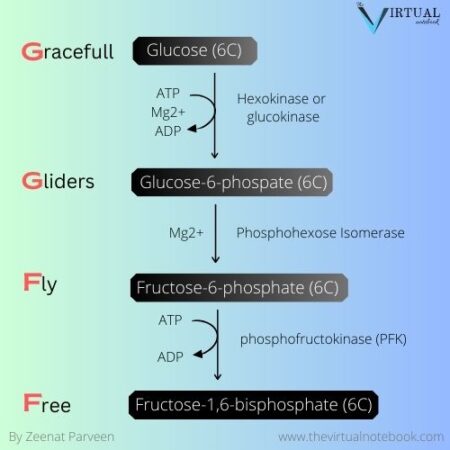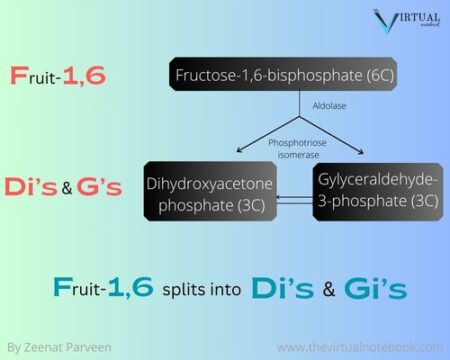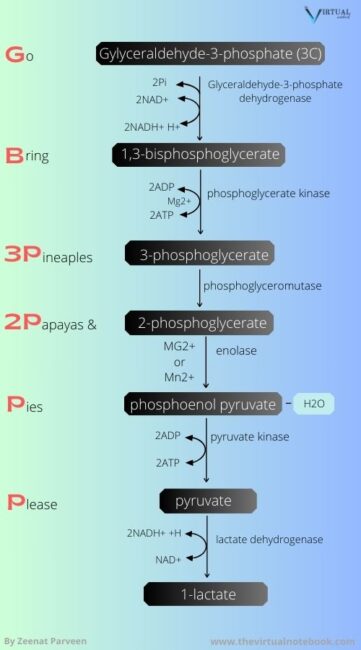Glycolysis is a vital process in the complicated world of biology, yet students frequently find it difficult to understand because of its complexity. Fear not; we are going to provide you with the tricks of powerful mnemonics for learning glycolysis, enabling you to quickly understand this important biochemical mechanism.
I believe you guys already know the critical steps of glycolysis. If not, please check the cycle of glycolysis.
The Magic of Mnemonics
You start with glucose first. Glucose is phosphorylated to create glucose 6-phosphate, which is isomerized to fructose 6-phosphate and then phosphorylated once again to create fructose 1,6-bisphosphate.
Then, fructose 1,6-bisphosphate is divided into the two, three-carbon sugars glyceraldehyde 3 phosphate (G3P) and dihydroxyacetone phosphate (DHAP). We end up with two molecules of G3P after dihydroxyacetone phosphate is also transformed to Glyceraldehyde 3 phosphate.
G3P is then phosphorylated to create 1 3-bisphosphoglycerate, which is then changed into 3 phosphoglycerate, 2 phosphoglycerate, phosphoenolpyruvate, and lastly 2 pyruvate.
Certainly! Mnemonics can be a fun and effective way to remember complex processes like glycolysis. These memory enhancers have the ability to make glycolysis seem less difficult than it actually is.
Are you ready for a fascinating fact?
When it comes to glycolysis, did you know that it actually completed in a series of ten total steps?
That’s right – ten!
Glycolysis Mnemonics
Let’s make these steps easier to remember by breaking them down into bite-sized pieces with some excellent mnemonics! The mnemonic consists of three pieces.
Here are some creative mnemonics to help you remember the key steps of the glycolysis cycle:
Energy Investment Phase (Part 1 of glycolysis mnemonic)
Graceful Gliders Fly Free (preparatory phase)

This mnemonic represents the following steps:
- “Graceful” reminds you of glucose.
- “Gliders” signifies glucose-6-phosphate, the product of the first step.
- “Fly” stands for fructose-6-phosphate, which is the result of the isomerization of glucose-6-phosphate in the third step.
- “Free” represents fructose-1,6-bisphosphate, which is formed in the fourth step.
Splitting phase (part 2)
To remember the splitting of fructose-1,6-bisphosphate into dihydroxyacetone phosphate and glyceraldehyde-3-phosphate, you can use the mnemonic (Part 2):
Fruit-1,6 Splits into Di’s & G’s (splitting phase)

This mnemonic breaks down the process as follows:
- “Fruit-1,6” reminds you of fructose-1,6-bisphosphate.
- “Splits” signifies the cleavage of the molecule.
- “Di’s” represents dihydroxyacetone phosphate.
- “G’s” stands for glyceraldehyde-3-phosphate.
Oxidoreduction phase (Part 3)
To remember the steps of glycolysis from 1,3-bisphosphoglycerate to pyruvate, you can use the following mnemonic:
Go Bring 3 Pineapples, 2 Papayas & Pie Please

- “Go” represents Glyceraldehyde-3-Phosphate.
- “Bring” stands for 1,3-Bisphosphoglycerate.
- “3 Pineapples” signifies 3-phosphoglycerate.
- “2 Papaya” represents 2-phosphoglycerate.
- Pie points to Phosphoenolpyruvate.
- “Please” reminds you of Pyruvate.
This should help you remember the order of these intermediates from glyceraldehyde-3-phosphate to pyruvate in glycolysis.
Let’s summarize the complete cycle in our mnemonics:
- Graceful Gliders Fly Free (preparatory phase).
- Fruit-1,6 Splits into Di’s & G’s (splitting phase).
- Go Bring 3 Pineapples, 2 Papayas & Pie Please.
Other Biological Pathways Mnemonics
I hope you like these mnemonics.
FAQs
Q1: Can I create my own glycolysis mnemonics?
Absolutely! Custom mnemonics tailored to your preferences often prove even more effective.
Q2: Are there online resources for glycolysis mnemonics?
Yes, various educational websites and forums offer mnemonic devices for glycolysis. Explore and find the ones that resonate with you.
Q3: How frequently should I review these mnemonics for optimal retention?
Regular practice is key. Aim for daily or weekly reviews to solidify your memory.
Q4: Can mnemonics be used for other complex biology topics?
Certainly! Mnemonics are versatile tools applicable to memorizing various intricate biological processes.